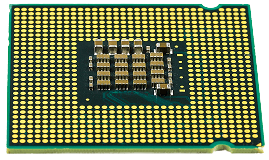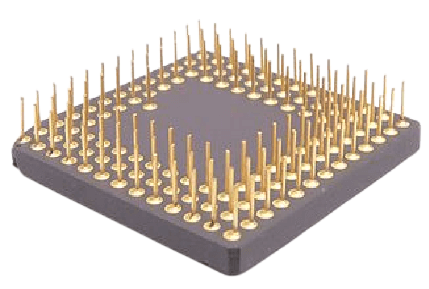Before you purchase a CPU socket, you must purchase the microprocessor. This is because AMD microprocessors need PGA sockets and Intel microprocessors generally need LGA sockets. In this article, we will provide a detailed comparison between LGA and PGA CPU sockets so that you can assess them better and purchase a microprocessor accordingly to meet all your requirements.
What Is A CPU Socket?
A CPU socket is the main connector between the microprocessor and motherboard of your computer. It is the main hub for inter-communication between the microprocessor and all the different parts on the motherboard. Therefore, it is one of the most important parts of your motherboard and computer as a whole. There are basically two variants of CPU sockets available namely – LGA and PGA. Let us understand LGA and PGA in detail now.
LGA – Land Grid Array
LGA stands for Land Grid Array. It works properly with the Intel chipsets. Intel motherboards and Intel core processors have sockets like LGA 1156, LGA 1200, and LGA 2011. LGA is the surface mounting packaging for ICs (Integrated Circuits). It has contact pins on the motherboard socket and not on the chip which sets it apart from PGA. Pros
No Damage – Since the pins are on the motherboard instead of the CPU, there is no chance of the CPU pins getting damaged. Besides, any mishandling or dropping of the socket will not damage the microprocessor which is the most expensive part of the motherboard. Less Space Requirement – LGA pins are small in size that helps to offer maximum space efficiency.
Cons
Complete Replacement – Accidentally breaking a pin on the LGA socket is hard to repair. Hence, you have to change the entire CPU socket. Easy Bending – You have to ensure carefully that the pins are well aligned. Otherwise, applying pressure without proper alignment will damage the CPU socket by making them bend.
Installing CPU on LGA Socket Motherboard
Intel continues to use LGA sockets in all of its processors. Using the triangle-shaped pins, the motherboard can connect to the processor. It comes with connector pads underneath. You can easily install a CPU on the LGA socket and here are the steps.
Step 1: Begin by opening the bracket with the help of a metal lever. Step 2: Align it horizontally with the CPU with an error of 2 mm. It must be at a maximum of 4 mm drop and height. Step 3: Close the bracket using the lever. Make sure that you lock it securely. If you want to take the processor out, release the locking latch and pick up the processor from the center by using your first finger and thumb.
PGA – Pin Grid Array
Pin Grid Array is exclusively for AMD. The latest Ryzen processor also uses the PGA socket. What separates it from the LGA socket is that the contact pins are on the processor chip instead of the motherboard socket. Therefore, it is supported by processors that contact pins underneath them. Pros
No Damage – There will be no damage to the motherboard due to CPU misalignment. Easy Repairing – PGA socket allows you to repair the bent pin conveniently.
Cons
Risky – Separating the CPU from the socket is risky as the pins can break.
Installing CPU on PGA Socket motherboard (Step by Step)
Step 1: By using a lever, place the processor aligning it horizontally. Step 3: Make sure there is a distance of 2 mm. Step 4: You can use a lever to lock it. For taking the processor out, you have to move the lever up and hold the processor vertically.
Comparison – LGA vs PGA
Build Quality – PGA socket is rather fragile in comparison to LGA socket. There are chances of it getting easily damaged and this will make the CPU completely non-functional. In comparison, LGA socket is less risky. Durability – LGA socket offers a more durable CPU as the contact pins are on the motherboard socket. On the contrary, PGA socket offers a more durable motherboard as the pins are on the processor. Space Efficiency – LGA pins are smaller than PGA pins and hence, it offers more space efficiency which is always desirable. Installation – PGA socket offers better simplicity in installation compared to the LGA socket. Compatibility – PGA sockets are mostly compatible with Intel processors. On the contrary, LGA sockets are suitable for AMD processors.
Comparison Summary Table
Why Are There Different CPU Sockets?
Two of the most common types of sockets are PGA and LGA. However, there are other types of CPU sockets available such As BGA and ZIP sockets. Let us discuss them one by one. PGA – The Pin Grid Array or PGA socket has several holes in an array. Even the CPU has pins where the arrangement of pins will correspond with the socket. However, if there is no proper alignment, there may be chances of damaging the pins. LGA – Unlike the PGA socket, Land Grid Array or LGA socket features slots with connectors. You will only have to line up the pins and give a slight pressure. LGA sockets are less fragile and allow you to solder them down conveniently. BGA – BGA socket stands for Ball Grid Array socket. It comes with copper pads soldering. With this type of socket, you don’t have to worry about any type of damage. It also makes sure there will be less distance for data to travel. ZIP – Finally, we have a ZIF or Zero Insertion Force socket. This is an extension to the PGA socket and you don’t have to worry about pressing hard on the CPU. Using a ZIF socket helps to reduce the chances of damaging the CPU.
Does CPU Socket Type Matter?
Different types of computer processors require different types of CPU sockets. Not all of them come with Universal CPU compatibility. A socket type matters extremely as it connects the CPU to the motherboard. Socket types for the LGA are categorical. LGA sockets have names according to the number of pins. For example, in the LGA1155, you will find a total of 1155 individual socket pins. This means that it will specifically work with a processor that can accommodate 1155 socket pins. Keep in mind that a single CPU socket is compatible with multiple CPU generations. However, AMD prefers to label its sockets with names like FM1 and AM3. Even if it comes with occasional upgrades, it does not compromise compatibility. In an upgraded form, it comes with the ‘+’ symbol like AM3+ and AM2+. In short, a CPU socket matters a lot in the construction of your computer for superior performance.
Conclusion – Which One Is Better?
Both sockets come with their own advantages and disadvantages. However, the LGA socket offers better convenience. Even if there is a bent pin, it will not cause any damage to the motherboard. However, if you have already bought the processor or you have a specific preference for processor brand, you have to purchase LGA for Intel processors and PGA for AMD processors. Comment * Name * Email * Website
Δ







![]()